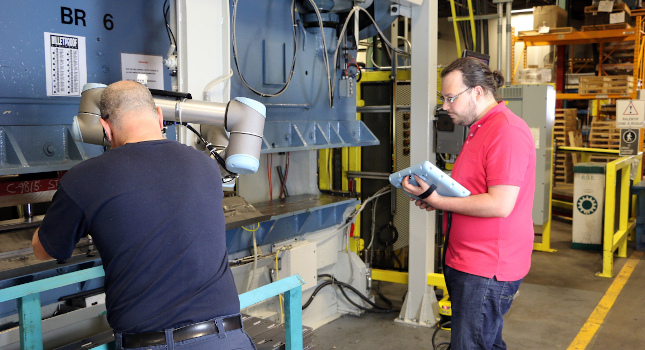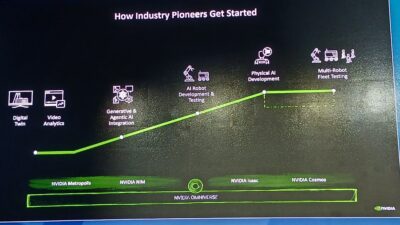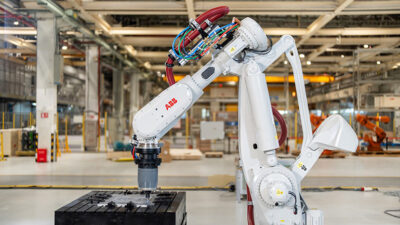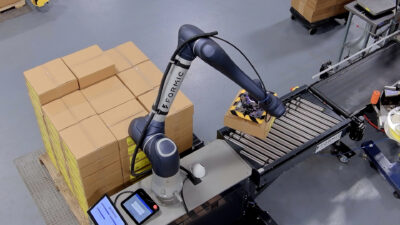Making robots compliant regardless of the environment is a challenge, but there are several things companies can look out for. See three questions companies should ask.

Compared to traditional industrial sectors, robotics is a relatively young field with only about 40 years of deployment history in workplace environments. Technology within this field however is advancing incredibly fast, and thus, compliance needs to be adaptable to keep pace with these rapid changes. Another challenge is conveying the many facets of compliance comprehensibly to end customers and integrators to clear up issues such as: When is a robot system really compliant? And what are the requirements to which the robot and robot system have to comply? Companies should keep in mind three aspects of robotic compliance.
1. What is compliance in robotics?
The first thing to be clarified for compliance is what industry and for which purpose will this robot system be used. Compliance requirements differ from application to application, for example, EMC thresholds, temperature, indoors/outdoors, performance or accuracy, work environment and whether employees can come into contact with the robot application.
For other work environments, such as electronics, pharma-production or foods, there could be additional requirements, such as cleanroom use or washdown. The robot is the arm or manipulator with its controller while the robot system is the robot plus the end-effector for the intended application or use.
Depending on the application and industry, there are very different expectations. This is also true for compliance in a safety context, especially when it comes to human-robot-collaboration without guards (“cage-free”). Keep in mind that there are excellent collaborative application using safety laser scanners and these applications are also “cage-free” (no perimeter guard). The fundamental point is that the robots permitted to contact a person are those with power and force limiting (PFL) capabilities.
2. What are the challenges for compliance in robotics?
Robot arms are often mountable in many different ways, such as to a wall, upside-down or on top of a table or mobile platform,and can be equipped with various end-effectors. Robot integrators face further challenges: Will the robot system be compliant for collaborative and “cage-free” use after the addition of end-effector and parts?
First, some questions need to be answered. The parameters needed — payload, reach, performance, etc. — have to be clarified for the robot and the additions that be used in a robotic system. From a compliance point of view, many different additional factors exist when a “cage-free” collaborative application is desired. These need to be taken into account.
We tackle this challenge in two ways: First, we only guarantee compliance of our “partial machine” — that is, the robot (arm or manipulator, controller and teach pendant) — to enable its use in collaborative applications. It is a power and force limited robot where the capabilities are provided by safety functions. Second, it should be emphasized to distributors and end customers that a risk assessment is required to make the robot application (robot system + additional parts and equipment) compliant, e.g. to safety standards including the technical specification ISO/TS 15066.
Furthermore, manufacturers need to be precise in their communication with their customers and partners. Robot manufacturers can only guarantee the compliance of their product to their specifications and approvals.
They can state the robot is accurate to the tenth of a millimeter or that the robot is power and force limited allowing it to be used in accordance with ISO/TS 15066 including Annex A. Annex A covers a range of force and pain threshold values in which a collaborative robot system can be used without guards and protective devices.
Manufacturers need to provide safety function information because this is critical to the safe integration and application of robots. Yet it is common to see claims of a “safe collaborative robot” with nothing to back it up and nothing to explain what “safe and collaborative” means.
The premise of most collaborative robots to limiting harm is by use of the robot’s safety functions. This means compliance with either ISO 13849 or IEC 62061. But it is often difficult to determine what safety functions are provided with a robot.
As a manufacturer, we do our utmost to inform our distributors and end-customers about our robot as comprehensively as possible. We lead the industry in disclosure of our safety certifications and our safety function details.
However, robots are being used in many different sectors, which means we aren’t able to cover all the applications that partners and end customers might conceive. So far, we have been surprised with some of the applications developed by our customers and we expect more pleasant surprises in the future.
3. Who is responsible to test for compliance?
Manufacturers do their utmost to ensure compliance of their products to their stated intended uses and to as many use cases as they can envision, if reasonable. However, just as robotic technology is ever advancing, so is the ingenuity of integrators and end users. As integrators uncover new ways to use and develop robot applications, they have to ensure the complete application complies with applicable requirements. For collaborative applications, these requirements depend on the robot application’s work environment, force values, shape and weight of the end-effector and workpiece and the maximum permissive speed of the robot for the application to remain within selected pressure and force values.
We need common ground
There is no unified test apparatus and procedure to test whether an application meets the free-space (transient) contact thresholds, so many have come up with their own testing methods. This results in different forces being measured due to the differing techniques. Thus, differences can arise in determining the limits which each robot should be configured so the PFL collaborative application is compliant.
Compliance managers need a common and comprehensively accepted tool to measure or simulate the quasi-static and transient contact values for a given application. There is a need for more sophisticated protective devices that have greater interaction with the robot control, to enable variable speeds as people are closer. And end-effectors will undergo many changes as attention turns towards reducing their risks. These are some of the next challenges for standardization to aid in the compliance collaborative and robotics technology.
Roberta Nelson Shea is chief technical compliance officer, Universal Robots. Edited by Chris Vavra, associate editor, Control Engineering, CFE Media and Technology, [email protected].
MORE ANSWERS
Keywords: collaborative robots, robot standards
Collaborative robots are useful for many manufacturing applications and are being used in innovative ways.
With these innovations, though, come potential hazards because the robots weren’t specifically designed for the applications they are being used for.
There is no common standard for collaborative robots for compliance managers for different applications.
Consider this
Which of the three highlighted questions is the one your company struggles with most and what has been done to address the problems?
Related Resources
Learn more about collaborative robots in these webcasts from Universal Robots:
Resolve robotic challenges using bin-picking intelligence
Collaborative robots are now skilled welders, what’s next?
The ROI of collaborative robots
Plug-and-play peripherals for collaborative robots
About the author
Roberta Nelson Shea is the Global Technical Compliance Officer at Universal Robots responsible for product safety and reducing barriers to global acceptance and deployment. She has spent more than 30 years as a manufacturing automation professional, 23 of them additionally chairing the American National Robot Safety Committee. She has also been elected one of the top 100 Women in Safety by the American Society of Safety Engineers (now known as ASSP). As chair of ANSI/RIA R15.06 has developed and defined various technical standards for industrial robots. Most recently, as chair of the committee ISO/TC 299 (ISO/TC 184/SC2), she led the introduction of ISO/TS 15066, which, as an extension of the established ISO 10218, is the first document defining standardized safety requirements within human-robot collaboration.



